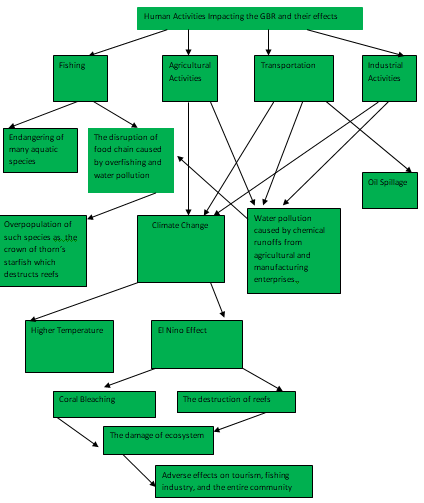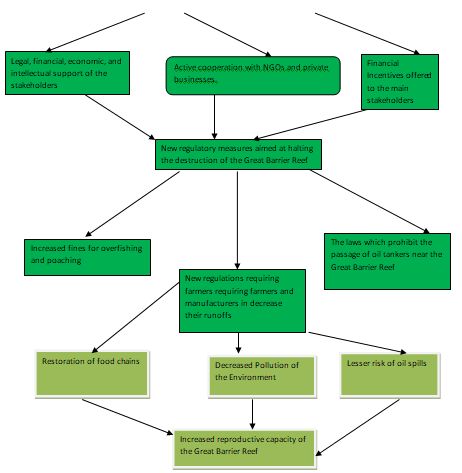Introduction
The Great Barrier Reef (GBR) can rightly be viewed as one of the most important natural resources in Australia. It is recognized as a World Heritage Site by UNESCO. However, this reef system is exposed to a great number of environmental threats, namely, water pollution, climate change, oil spills, overfishing, and so forth (Johansen 2009, p. 293).
Many of these threats can be attributed to human activities. Such situation can hardly be accepted and more strict laws are required to protect the GBR. The new regulations must raise environmental standards for agricultural and manufacturing enterprises. These standards are particularly important when we speak about waste management and reduction of pesticides runoff.
Furthermore, the official authorities must reduce overfishing in this area. In part, it can be done by imposing heavier fines on poachers. Secondly, these regulatory measures must protect this natural resource from the oil spills by making oil shipping companies change their transportation routes. This report is aimed at discussing the effects of human activity on the GBR.
Moreover, it must show how new regulations can affect various stakeholders. To a great extent, this report will rely on such tools as system analysis and stakeholder analysis. Finally, one of our tasks is to determine if the management of the Great Barrier Reef corresponds to the latest environmental standards. These are the main objective that must be attained.
System Analysis
The system analysis has to demonstrate how various actors affect the ecosystem of the GBR. Secondly, it must show the impacts of these activities on the other stakeholders. Moreover, this analytical method must indentify the so-called positive and negative feedback loops.
This method will help us understand the causal relations between various elements of this socio-environmental system. Overall, these cause/effect network can be illustrated by means of the following diagrams.


The first diagram indicates that the effects of human activities on the GBR may not be necessarily direct, and sometimes they are very difficult to trace. For example, the increased emission of greenhouse gases can be associated with the increased number of El Niño events. In turn, these variations of temperature can be ruinous for coral reefs (Arnold 2005, p. 30).
They can be the underlying cause of coral bleaching (Arnold 2005, p. 30). Thus, one can say that to a large extent, the survival of the Great Barrier Reef depends upon the government standards which regulate the emission of greenhouse. The changes in such regulations can affect a wide range of industrial enterprises.
As far as this issue is concerned, we can say that Australia is one of the first countries to implement legislation and standards reducing the emission of greenhouse gases. Besides, such problem as climate change requires joint international cooperation.
This is why this report will focus on those problems which can be addressed by local rather than international authorities. For example, excessive fishing and water pollution can disrupt food chain and result in the overpopulation of the so-called crown-of-thorn starfishes that are partially responsible for the destruction of coral reefs (Shea 2006, p. 20).
Additionally, this diagram shows that there are several agents cause damage to the ecosystem of this area. First of all, one can speak about the agricultural and industrial enterprises which pollute water by damping their wastes into the rivers. This subsequently affects the nutrition of reefs and the food chain in this aquatic region. Moreover, one should not forget about which transport oil near the Great Barrier Reef.
We should bear in mind that within the last two there decades there have been more than two hundred oil spills in this area (Hutchings, Kingsford & Hoegh-Guldberg 2009., p 225). Such oil spills pose an enormous threat to aquatic life and cause the destruction of reefs. One of the possible solutions to this problem is make oil companies change their transportation routes. Yet, they can be unwilling to comply with this requirement.
We should take into consideration that coral reefs can be viewed as one of the most efficient ecosystems (National Research Council et al, 2000, p 195). They can thrive even in those waters which are not abundant in nutrients, but overload of nitrogen and other pollutants can reduce their reproductive capacity. Therefore, special attention should be given to agricultural and manufacturing companies.
It should be noted that there are many stakeholders who can sustain losses due to these environmental risks. In particular, one should speak about the entire tourism industry in Queensland.
One can mention the employees of tourist agencies, hotels, restaurants, excursion companies, and other organizations or people who benefit from the continuous inflow of visitors to Australia (Australian Bureau of Statistics, 1998, p. 705). One should keep in mind that this industry can bring more than one billion dollar a year. Therefore, its decline will be harmful to the entire community.
Additionally, we need to remember that the damage of the Great Barrier Reef ecosystem can backfire on fishing industry. Continuous water pollution and poaching can may decrease the population of many species and reduce the profitability of many companies. Thus, by engaging in overfishing many companies can eventually put themselves in a very perilous position.
Hence, some of these enterprises can also be interested in the preservation of the GBR ecosystem. The management of the GBR has to be based on the study of ecosystem and its functioning. By overlooking it, the official authorizes put the well-being of the entire community at risk.
These are the main issues that policy-makers should consider. The policies that we proposed can be supported by various stakeholders, and they can significantly reduce the risks for the GBR. Yet, they can achieve success only if the government actively cooperates with private companies and NGOs.
The analysis of stakeholders
At this point it is necessary for us to apply stakeholder analysis to this situation. On the one hand, its purpose is to explain the interests and attitudes of people and organizations affecting the Great Barrier Reef.
Secondly, we need to explain how these stakeholders can react to the new regulations that strive to protect the Green Barrier Reef from destruction. On the basis of this analysis, one can better map out further strategies of the government.
Stakeholder Analysis Table.
These table shows that the overwhelming majority of stakeholders will not oppose the implementation of regulations which are aimed at protecting the Green Barrier Reef. They have sufficient legal, financial, intellectual, and political power in order to influence the decisions of the government. As it has been shown in the table some stakeholders have mixed interests.
On they one hand, they want to increase their profitability, and new regulations may not always be beneficial to them. However, they also realize that their long-term sustainability depends on the preservation of Australian natural resources, including the Great Barrier Reef. The only exception to this rule is oil companies which may be reluctant to change the transportation routes.
However, the hypothetical conflict can be resolved through negotiation. For instance, they can raise safety standards for oil tankers. Another important issue is how to align these stakeholders so that they could join their efforts. This task should be performed by governmental agencies, research or educational institutions, and non-governmental organizations. Without such cooperation, legislator changes are not likely to occur.
The analysis of the environment management system
At this point, it is necessary for us to determine whether current management and policies related to the Great Barrier Reef comply with international norms. For instance, we can refer to the rules set by the International Organization for Standardization. These rules are also known as ISO 14000. There are several important aspects of these standards, and they will be discussed in the following table.
Thus, this table shows that current management of the Great Barrier Reef can be significantly improved. First of all, one should focus on the scope and purpose of policies. The government has to identify each of the factors which contribute to the destruction of the GBR and develop a set of clear-cut and feasible strategies to alleviate these factors.
The second drawback that one can point to is the communication with community and major stakeholders. The thing is that that their plan has to take into peculiarities of local farming enterprises and manufacturing companies.
This plan does explain how these organizations have to change or update their technologies and waste management practices. More importantly, they do not show how the government can assist these companies. This is one of the reasons why their initiatives cannot be accepted by private organizations.
Overall assessment of the case
The decision to tighten control over the pollution of waters and overfishing in the aquatic area of GBR can protect this ecosystem from environmental threats. First of all, these initiatives appear to be plausible from political point of view. It will be supported by many influential stakeholders like the representatives of tourism industry and local residents.
Secondly, some aspects of this plan can be negotiated with farmers and manufacturing companies. In part, the government can gain their support by offering financial support to those organizations which adopt eco-friendly technologies. However, some technical aspects of this decision still have to be negotiated. In particular, it is vital for the companies to develop the plans for implementing the new technologies.
This intiatives can be effective only if governmental agencies, NGOs and private companies work hand in hand. This is the indispensible condition for success. Finally, these initiatives can be properly implemented only if policy-makers gain support gain political, economic, and intellectual support of stakeholders.
References
Arnold, C., 2005. El Niño: Stormy Weather for People and Wildlife. NY: Houghton Mifflin Harcourt.
Australian Bureau of Statistics, 1998. Year book, Australia. Melbourne: Aust. Bureau of Statistics.
Australian Bureau of Statistics, 2008. Year book, Australia. Melbourne: Aust. Bureau of Statistics.
International Organization for Standardization. 2004. ISO 1400 Essentials. Web.
Hutchings, P. A., Kingsford M., & Hoegh-Guldberg, O., 2009. The Great Barrier Reef: biology, environment and management. Melbourne: Csiro Publishing.
Johansen, B. E., 2009. The Encyclopedia of Global Warming Science and. Technology. London: ABC-Clio.
Morris, M., 2004. ISO 14000 environmental management standards: engineering and financial aspects. NY: John Wiley and Sons.
National Research Council (U.S.). Ocean Studies Board, National Research Council (U.S.), 2000. Water Science and Technology Board, 2000, Clean coastal waters: understanding and reducing the effects of nutrient pollution. Washington: National Academies Press.
Queensland Government, 2009. Reef Water Quality Protection Plan. Web.
Shea, T., 2006. The Great Barrier Reef: using graphs and charts to solve word problems. Melbourne: The Rosen Publishing Group.
Vorley, W., & Keeney, D., 1998. Bugs in the system: redesigning the pesticide industry for sustainable agriculture. NY: Earthscan.